From protesting the Vietnam War to founding the Youth International Party, Abbot Howard "Abbie" Hoffman became one of the most iconic activists of the New Left.
Abbie Hoffman was one of the most passionate and eccentric American political activists of the 1960s. He fought social injustice, nurtured the country’s antiwar movement, and highlighted political corruption — and he did it in style.
While some of Hoffman’s protests were more traditional, he was never afraid to orchestrate the outlandish to attract an audience. From showering the floor of the New York Stock Exchange with fake money to trying to levitate the Pentagon with his mind, he was a master of theatrics.
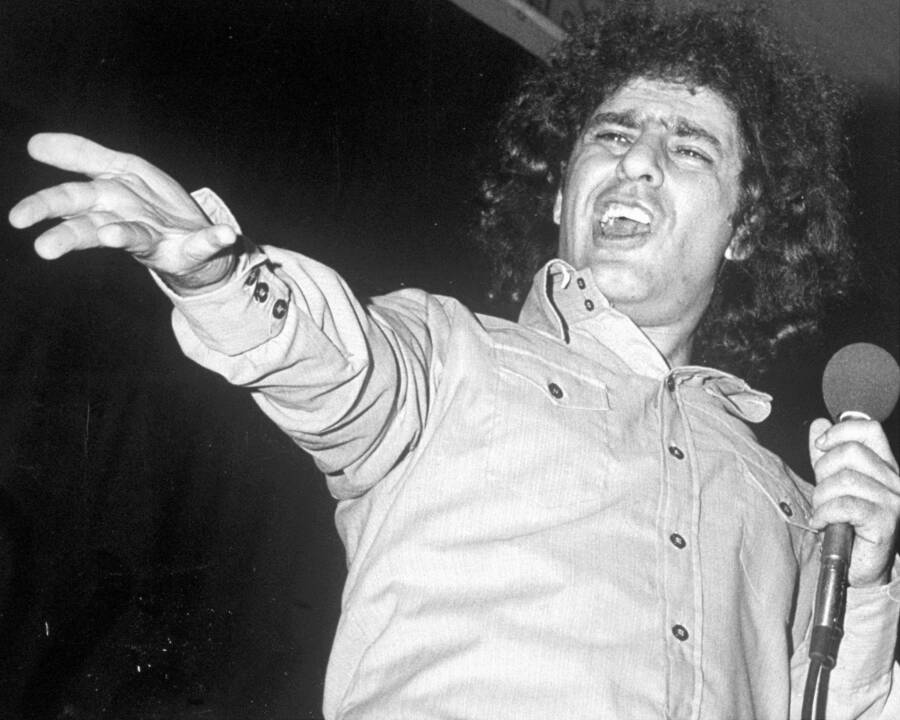
Thomas Monaster/NY Daily News Archive/Getty ImagesAbbie Hoffman was known for being a fiery American political activist.
But after the massive antiwar protests at the 1968 Democratic National Convention, Hoffman was charged with conspiracy to incite a riot while crossing state lines as part of the Chicago Seven.
Put on trial with six other antiwar activists, Abbie Hoffman’s fiery criticism of the government was on display for all the world to see. And he didn’t stop his dramatic demonstrations just because he was in a courtroom.
In October 2020, Aaron Sorkin’s new Netflix film The Trial of the Chicago 7 will showcase Hoffman’s legendary activism. But even though Hoffman’s outrageous life was a perfect fit for a movie, the real Hoffman certainly didn’t have a Hollywood ending.
Who Was Abbie Hoffman?
Abbot Howard Hoffman was born on November 30, 1936, in Worcester, Massachusetts. His parents, John Hoffman and Florence Schanberg, were modest, middle-class, and Jewish. Hoffman was a troublemaker from an early age, playing neighborhood pranks and getting into fights.
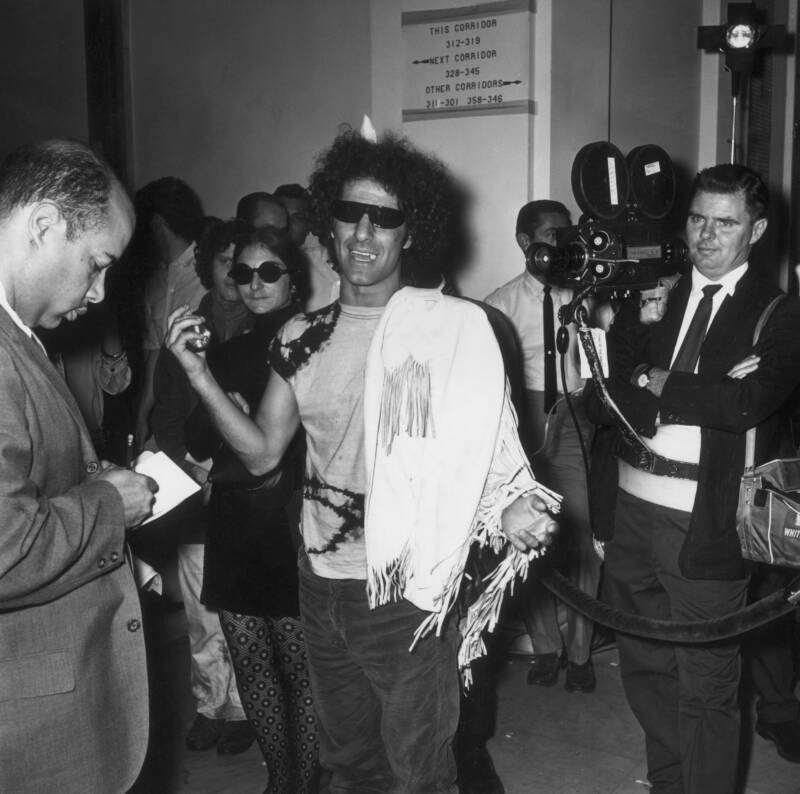
Hulton Archive/Getty ImagesHoffman before testifying for the House Committee on Un-American Activities in October 1968.
Having discovered atheism while he was in school, Hoffman wrote a paper that declared that there couldn’t be a God, because if there were one, he would dispense rewards and punishments fairly and justly. In response, his teacher called him a “little Communist bastard” while tearing his paper to shreds. Hoffman tackled him — and was promptly expelled.
However, Hoffman later thrived in college. His interest in psychology led to him getting a bachelor’s degree from Brandeis University in 1959. He then picked up a master’s degree at the University of California, Berkeley in 1960. His time in school arguably nurtured a strong foundation for his later work.
The Theatricality Of Activism
While at Brandeis, Hoffman studied under Marxist theorist Herbert Marcuse. He also learned from Abraham Maslow, who was considered a figure of humanistic psychology. Maslow undoubtedly fostered Hoffman’s desperation to help the downtrodden. Ironically enough, Maslow disapproved of Hoffman’s later activism, especially during the Vietnam War years.
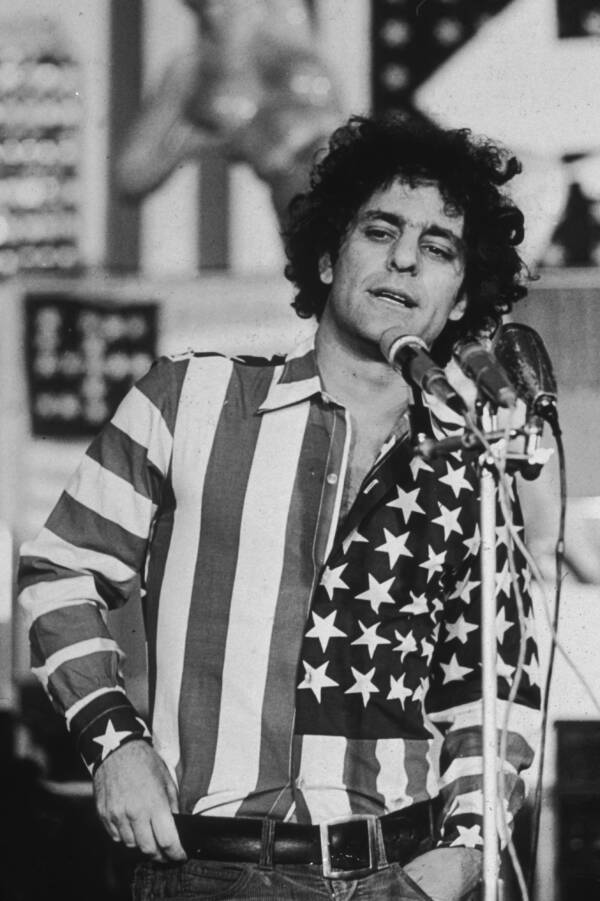
Tyrone Dukes/New York Times Co./Getty ImagesHoffman speaking at a New York art show, before being charged with desecration of the U.S. flag.
In college, Hoffman helped the Student Nonviolent Coordinating Committee organize the “Liberty House” to sell items to support the Southern civil rights movement. But before long, the escalation of the Vietnam War quickly captured Hoffman’s attention.
By 1966, he’d fully immersed himself in the counterculture and could reasonably be described as a hippie — but one who was organized and focused on spearheading a sociopolitical movement.
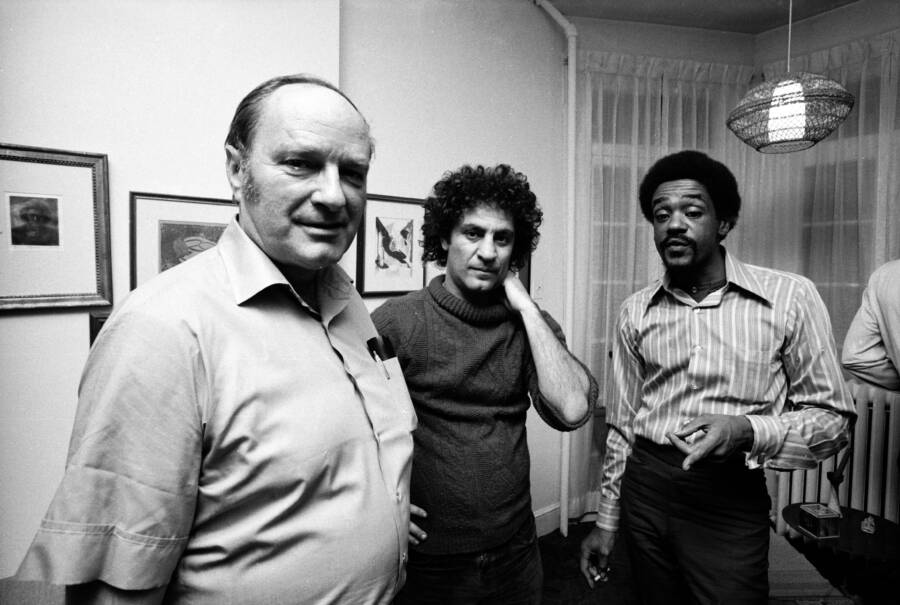
John Olson/The LIFE Picture Collection/Getty ImagesDavid Dellinger, Abbie Hoffman, and Black Panther co-founder Bobby Seale at Seale’s birthday party in New York.
While fighting for Black equality was important to Hoffman, he also believed their plight was a symptom of a larger disease — the American political system as a whole. So he thought that focusing on the power structures themselves was essential to the movement.
In 1966, he met with the Diggers — a progressive street theater group — and he quickly learned how theatrics could help people understand the causes he was fighting for. Based in San Francisco, the Diggers saw activists use street performances to raise awareness of modern-day issues. It was a tactic that Hoffman wholeheartedly embraced.
Founding The Youth International Party
Hoffman helped found the Youth International Party (YIP), a group better known as “Yippies,” in the late 1960s. The Yippies were a loose group of anarchists, artists, and societal dropouts who embraced eccentric theatricality to “stick it to the man.” In August 1967, Hoffman took that approach to the New York Stock Exchange.
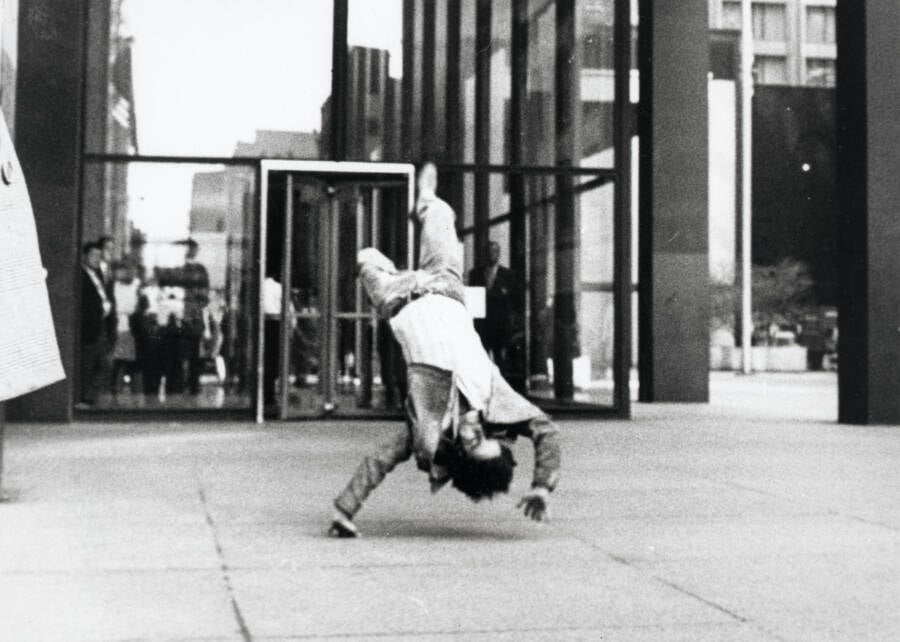
Bettmann/Getty ImagesHoffman theatrically somersaults into federal court on his second day of the Chicago Seven trial. Sept. 25, 1969.
Disrupting traders in the stock exchange gallery by showering them with fake dollar bills, Hoffman and his friends were instantly plastered all over global media outlets. After the stunt, the New York Stock Exchange reportedly spent $20,000 to install bulletproof glass around the trading gallery.
That October, Hoffman’s work scaled to bigger proportions when he worked with David Dellinger of the National Mobilization Committee to End the War in Vietnam (MOBE) — to attract followers to a march on the Pentagon.
On Oct. 21, 1967, the YIP walked through America’s capital with at least 100,000 protestors. Though they were met by soldiers of the 82nd Airborne Division at the Pentagon steps, Hoffman was determined to make a splash. With poet Allen Ginsberg leading Tibetan chants, Hoffman attempted to levitate the Pentagon with his mind.
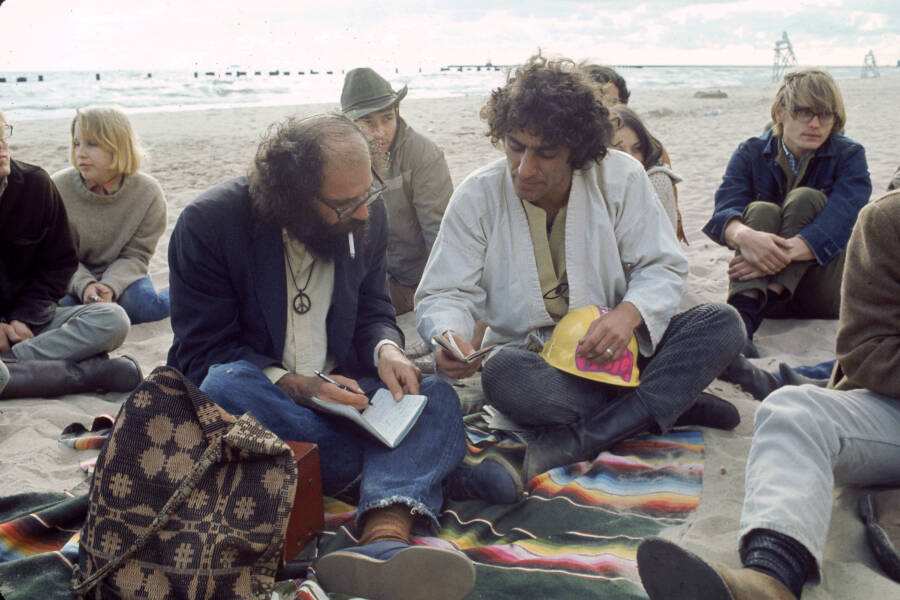
Julian Wasser/The LIFE Images Collection/Getty ImagesPoet Allen Ginsberg comparing notes with Abbie Hoffman during the 1968 Democratic National Convention.
But despite the massive demonstration, the Vietnam War would continue for another eight years. And the following year, Hoffman would face more resistance to his ideas than ever before.
The True Story Of The Chicago Seven
By 1968, there were hundreds of organizations that adamantly opposed the Vietnam War. Their ideologies ranged from the peaceful resistance employed by Dellinger’s MOBE to more militant groups like the Students for a Democratic Society (SDS).
With the Democratic National Convention looming on the horizon in August 1968, several activists met up to coordinate an antiwar protest. These meetings, which included more than 100 groups, would later be used as evidence for conspiracy charges against Hoffman and his cohorts.
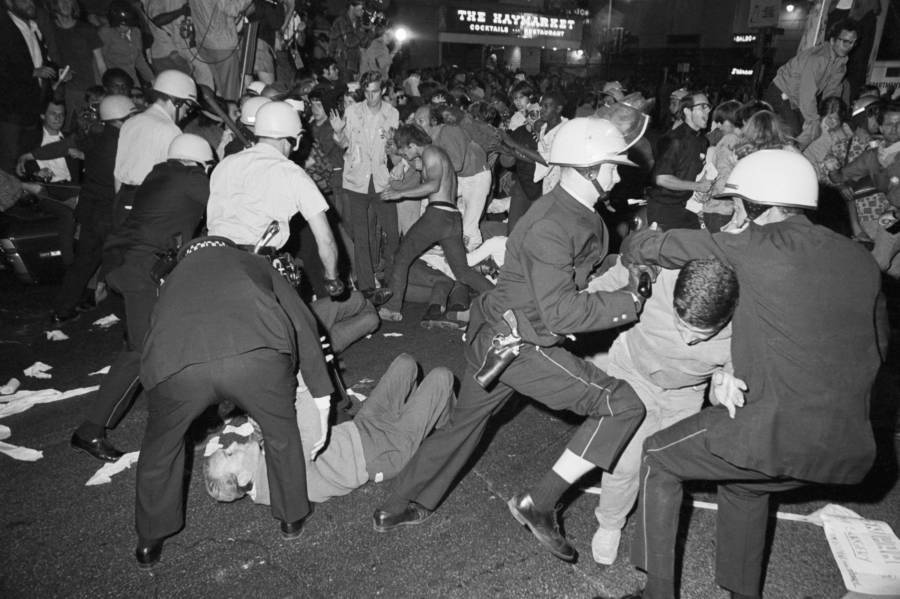
Bettmann/Getty ImagesThe 1968 Chicago riots.
The Democratic National Convention was held from August 26th to the 29th in the International Amphitheater in Chicago, Illinois. President Lyndon B. Johnson had already declared that he wasn’t seeking reelection, so the Democratic Party had focused on finding a new nominee — with demonstrators demanding that the candidate should be antiwar.
Unfortunately, the protests led to multiple days of bloodshed in Chicago, with countless people injured. Hundreds of protesters were arrested, with estimates ranging from 589 to over 650.
Among those arrested were the men who would later be known as the Chicago Seven (originally the Chicago Eight, and sometimes called the Conspiracy Eight or Conspiracy Seven): Abbie Hoffman, Jerry Rubin, David Dellinger, Rennie Davis, John Froines, Lee Weiner, and future California state senator Tom Hayden. While Black Panther Party co-founder Bobby Seale was initially the eighth defendant, he was later ordered to stand trial separately.
Abbie Hoffman And The Chicago Seven On Trial
Presided by Judge Julius Hoffman, the trial saw all eight defendants charged under provisions of the Civil Rights Act that made it a federal crime to cross state lines to incite a riot. The five-month trial began in September 1969 — and it was rife with controversy from the start.
After Seale complained about not being able to choose his own lawyer, he was ordered to appear before the jury bound, gagged, and chained to a chair. Soon after, Seale was removed from the case and ordered to stand trial on his own — leaving the others with the infamous Chicago Seven moniker. And they did not enter the courtroom quietly.
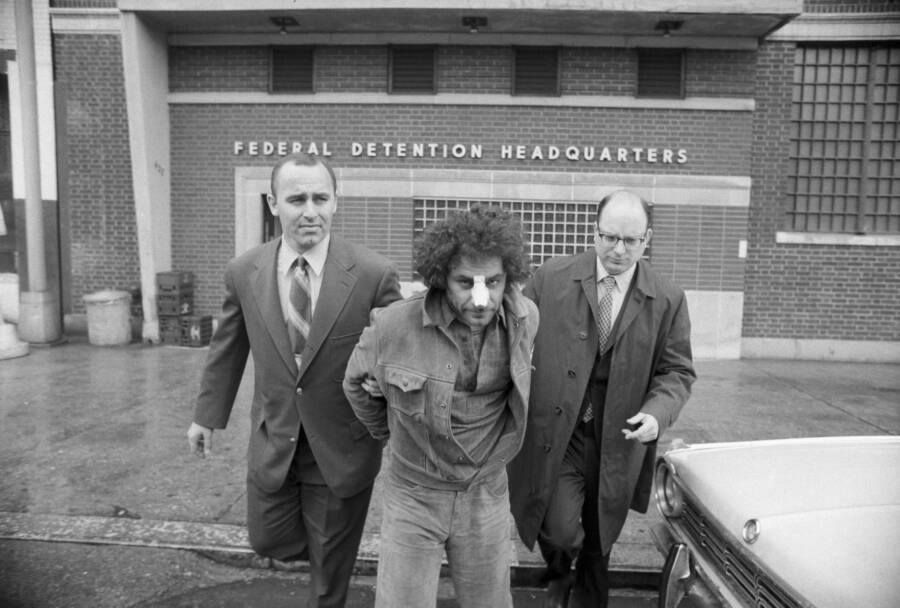
Bettmann/Getty ImagesFBI agents escort the injured Chicago Seven defendant to court.
“This court is bullsh-t,” Davis and Rubin declared. Bold as ever, the group continued to use theatric strategies to make a point — despite the serious charges they were facing.
At one point, Hoffman and Rubin entered the courtroom dressed in judicial robes, with Chicago police uniforms underneath. Another time, Hoffman extended his middle finger while he was sworn in as a witness. The Chicago Seven as a whole regularly insulted the judge to his face, with Hoffman calling him a “disgrace for the Gentiles” in Yiddish.
“Your idea of justice is the only obscenity in the room,” he told the judge.
Though the group had character witnesses vouch for them, all seven defendants were found guilty of contempt of court in February 1970. And all but Froines and Weiner were found guilty of crossing state lines with the intention of starting a riot. They were sentenced to five years in prison and fined $5,000.
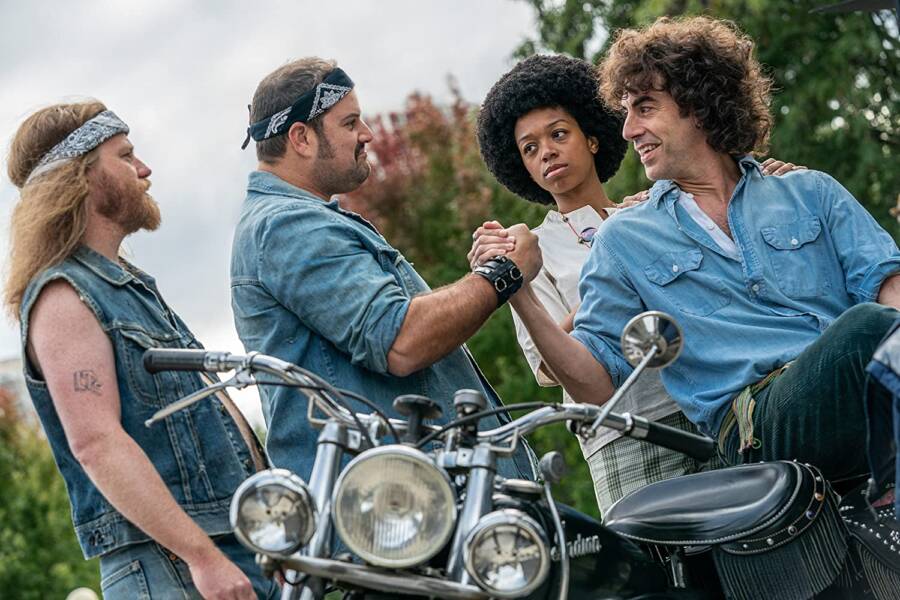
NetflixSacha Baron Cohen as Abbie Hoffman in The Trial of the Chicago 7.
However, none of the seven were found guilty of conspiracy. And ultimately, none of them would serve time. Due to the judge’s procedural errors and his overt hostility to the defendants, a Court of Appeal overturned the criminal convictions in 1972.
The End Of An Era
One of Hoffman’s most infamous moments remains his “incident” at the 1969 Woodstock Festival. He interrupted The Who’s performance to speak up for John Sinclair, a White Panther Party activist who had just been sentenced to 10 years in prison for possession of marijuana.
“I think this is a pile of sh-t while John Sinclair rots in prison,” Hoffman howled into the microphone. The exchange can still be heard on The Who’s Thirty Years of Maximum R&B.
This moment arguably foreshadowed Hoffman’s decline into a more dispirited state. After the Chicago Seven trial, he shifted into the somewhat quieter life of a writer. His 1971 guide, Steal This Book, instructed readers on how to “live for free” — and saw some bookstores pull it from their shelves after people took the title literally and started stealing it en masse.

Bettmann/Getty ImagesJerry Rubin, Abbie Hoffman, and Rennie Davis address reporters amidst their trial. Feb. 14, 1970.
But nothing set the stage for his final years more than his 1973 arrest for trying to sell $36,000 worth of cocaine. Jumping bail, Hoffman went on the run for over six years.
After receiving plastic surgery on his nose and giving himself the new name of Barry Freed, Hoffman settled in upstate New York. But he soon tired of life as a fugitive and surrendered himself to authorities in 1980.
The Last Years Of A Counterculture Hero
Though he agreed to plead guilty to a reduced charge of possession, Hoffman was still sentenced to up to three years in prison in April 1981. He only ended up serving about a year. But when he realized that protest culture was on the decline, Hoffman felt defeated.
Much had changed since Hoffman had last been in the public eye — and he felt that young people had become more self-centered and less concerned with changing society for the better.
On April 12, 1989, Hoffman was found dead in his bed at his Pennsylvania apartment after swallowing 150 phenobarbital tablets. He was just 52 years old when he died and his death was ruled a suicide.
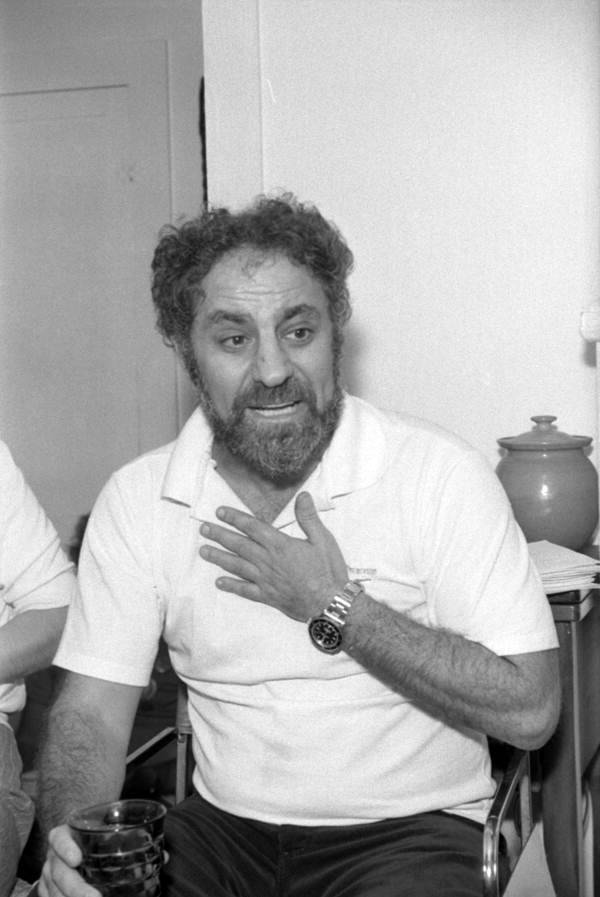
Wikimedia CommonsHoffman in Tallahassee, Florida, the same year he committed suicide.
While Hoffman’s story had a sad ending, his legendary activism remains a powerful snapshot of the counterculture of the 1960s and ’70s. He was even portrayed in the 1994 movie Forrest Gump, speaking out against “the war in Viet-f-cking-nam.” In October 2020, his role in the antiwar movement will be explored much more fully in Netflix’s The Trial of the Chicago 7.
Hoffman’s ideals were best described in 1987, when he explained his goals:
“You are talking to a leftist. I believe in the redistribution of wealth and power in the world. I believe in universal hospital care for everyone. I believe that we should not have a single homeless person in the richest country in the world. And I believe that we should not have a CIA that goes around overwhelming governments and assassinating political leaders, working for tight oligarchies around the world to protect the tight oligarchy here at home.”
After learning about Abbie Hoffman, check out photos that capture the 1960s. Then, learn about the history of hippies.






